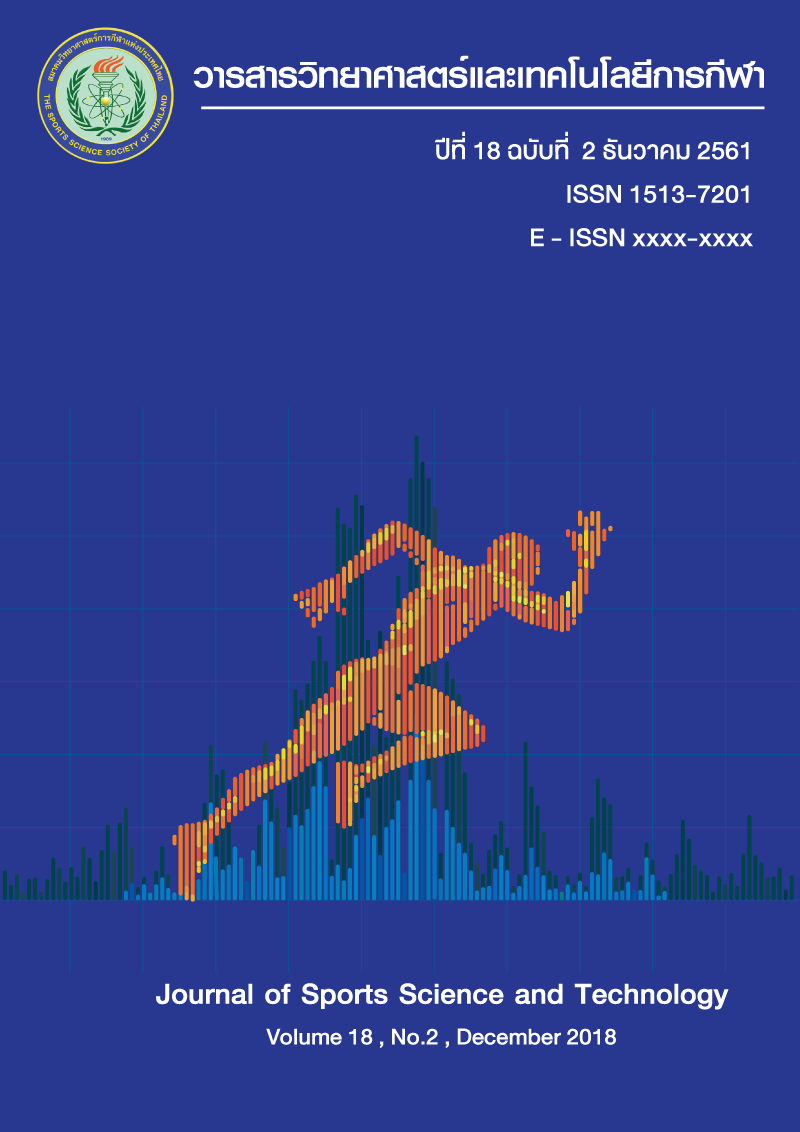CHRONIC EFFECT OF PROPRIOCEPTIVE NEUROMUSCULAR FACILITATION STRETCHING ON FLEXIBILITY AND STRENGTH
Keywords:
Contract-relax PNF stretching / Agonist/antagonist stretching / In-season training; Range of motion / Hamstring/Quadriceps ratioAbstract
Stretching is usually included in the regular training program or part of warm-up activity before exercises. However, it is not that popular during the in-season training as it could compromise the muscle strength. Contract-relax proprioceptive neuromuscular facilitation (CR-PNF) stretching is generally known as an effective method to increase the joint range of motion, implying flexibility, but the chronic effect on muscle strength was not much studied. The aim of this study was to investigate the chronic effects of 4-week CR-PNF stretching on muscle strength, i.e. the knee flexor (hamstrings) and knee extensor (quadriceps) during the in-season training of professional soccer players. Thirty-one male professional soccer players received the CR-PNF stretching of hamstring and quadriceps muscles for 4 weeks during the in-season training. Hip and knee range of motion and hamstring flexibility (sit-and-reach test) were measured before, at the end of each week and two weeks after the stretching session in order to see if the range of motion was maintained. Knee flexion and extension isokinetic strengths were tested before and two weeks after the stretching session. Isokinetic Hamstring/Quadriceps (H/Q) ratios were also assessed. The range of motion was progressively increased from the baseline measurement as can be observed since week 2 for hamstring (hip and knee extension) and week 3 for quadriceps (hip and knee flexion), similarly for both dominant and non-dominant legs. At two weeks after the intervention, the range of motion was not significantly different from week 4 (p>0.05) but significantly improved as compared to the baseline (p<0.05). Isokinetic knee flexion strength was significantly improved (p<0.05) but not the case for extension strength (p>0.05). H/Q ratios were significantly improved after the intervention (p<0.05). It was concluded that during the in-season training, CR-PNF stretching was effectively able to increase the flexibility without the detrimental chronic effect on muscle strength. Improved muscle balance (H/Q ratio) consequently from the increased isokinetic flexion strength also suggested the positive effect on injury prevention. (Journal of Sports Science and Technology 2018; 18(2): 9-20) Keywords: Contract-relax PNF stretching / Agonist/antagonist stretching / In-season training; Range of motion / Hamstring/Quadriceps ratio
*Corresponding author: Korakod PANICH
College of Sports Science and Technology Mahidol University,
Nakhon Pathom, Thailand 73170
E-mail: [email protected]
References
2. Akbulut T, Agopyan A. Effects of an Eight-Week Proprioceptive Neuromuscular Facilitation Stretching Program on Kicking Speed and Range of Motion in Young Male Soccer Players. J Strength Cond Res. 2015;29(12):3412-23.
3. Bradley PS, Portas MD. The relationship between preseason range of motion and muscle strain injury in elite soccer players. J Strength Cond Res. 2007;21(4):1155-9.
4. Feland JB, Myrer JW, Merrill RM. Acute changes in hamstring flexibility: PNF versus static stretch in senior athletes. Phys Ther Sport, 2001; 2:186-93
5. Marek SM, Cramer JT, Fincher AL, Massey LL, Dangelmaier SM, Purkayastha S, et al. Acute Effects of Static and Proprioceptive Neuromuscular Facilitation Stretching on Muscle Strength and Power Output. J Athl Train. 2005;40(2):94-103.
6. Miyahara Y, Naito H, Ogura Y, Katamoto S, Aoki J. Effects of proprioceptive neuromuscular facilitation stretching and static stretching on maximal voluntary contraction. J Strength Cond Res. 2013;27(1):195-201.
7. Cengiz A, Demirhan B, Yaman C, Yaman M. Acute Effects of PNF Stretching on Maximum Voluntary Contraction in Men. The Anthropologist. 2015;21(3):500-4.
8. Higgs F, Winter SL. The effect of a four-week proprioceptive neuromuscular facilitation stretching program on isokinetic torque production. J Strength Cond Res. 2009;23(5):1442-7.
9. Handel M, Horstmann T, Dickhuth HH, Gulch RW. Effects of contract-relax stretching training on muscle performance in athletes. Eur J Appl Physiol Occup Physiol. 1997;76(5):400-8.
10. Medeiros DM, Lima CS. Influence of chronic stretching on muscle performance: Systematic review. Hum Movement Sci. 2017; 54:220-9.
11. Kannus P: Isokinetic Evaluation of Muscular Performance. Int J Sports Med. 1994;15: S11-S18 12. Sharman MJ, Cresswell AG, Riek S. Proprioceptive neuromuscular facilitation stretching: mechanisms and clinical implications. J Sports Med (Auckland, NZ). 2006; 36(11):929-39.
13. Hindle K, Whitcomb T, Briggs W, Hong J. Proprioceptive Neuromuscular Facilitation (PNF): Its Mechanisms and Effects on Range of Motion and Muscular Function. J Hum Kinet 2012.p.105.
14. Mitchell UH, Myrer JW, Hopkins JT, Hunter I, Feland JB, Hilton SC. Acute stretch perception alteration contributes to the success of the PNF "contract-relax" stretch. J Sport Rehabil. 2007;
16(2):85-92.
15. Ford P, McChesney J. Duration of maintained hamstring ROM following termination of three stretching protocols. J Sport Rehabil. 2007;16(1):18-27. 16. Rancour J, Holmes CF, Cipriani DJ. The effects of intermittent stretching following a 4-week static stretching protocol: a randomized trial. J Strength Cond Res. 2009;23(8):2217-22.
17. Funk DC, Swank AM, Mikla BM, Fagan TA, Farr BK. Impact of prior exercise on hamstring flexibility: a comparison of proprioceptive neuromuscular facilitation and static stretching. J Strength Cond Res. 2003;17(3):489-92.
18. Nelson AG, Chambers RS, McGown CM, Penrose KW. Proprioceptive neuromuscular facilitation versus weight training for enhancement of muscular strength and athletic performance. J Orthop Sports Phys . 1986;7(5):250-3.
19. Cheung RTH, Smith AW, Wong DP. H:Q Ratios and Bilateral Leg Strength in College Field and Court Sports Players. Journal of Human Kinetics. 2012;33:63-71.






